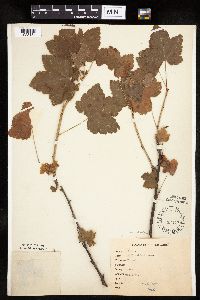Ribes rubrum
|
|
|
|
Family: Grossulariaceae
Northern Red Currant
[Ribes sativum Syme, moreRibes sylvestre Mert. & Koch, Ribes vulgare K.Koch] |
Plants (not strong-smelling), 0.5-1.5 m. Stems erect, nearly glabrous, crisped-puberulent (somewhat stipitate-glandular on young growth); spines at nodes absent; prickles on internodes absent. Leaves: petiole 3-6 cm, glabrous; blade suborbiculate, 5-lobed, cleft 1/3-1/2 to midrib, 2.5-4.5 cm, base truncate to cordate, surfaces not glandular, sparsely hairy on veins abaxially, glabrous adaxially, lobes broadly ovate-triangular, margins bicrenate-serrate, apex acute. Inflorescences ascending to pendent, 8-20-flowered racemes, 2-6 cm, axis glabrous, not glandular, flowers evenly spaced. Pedicels jointed, to 6 mm, glabrous, not glandular; bracts broadly ovate, 0.5-1 mm, glabrous. Flowers: hypanthium ochroleucous or greenish, saucer-shaped, 1 mm, glabrous; sepals nearly overlapping, spreading (revolute at tips), green or greenish brown, broadly deltate-ovate (abruptly narrowed to slender base), 2-2.5 mm; petals widely separated, erect, cream to pinkish, cuneate-flabellate, not conspicuously revolute or inrolled, 0.3-1 mm; nectary disc prominent, green, raised, 5-angled, covering top of ovary; stamens nearly as long as petals; filaments linear, 0.2-0.3 mm, glabrous; anthers white, dumbbell-shaped, 0.2-0.3 mm (broader than long), apex with U-shaped depression, (anther sacs distinctly separated by connective as broad as sac); ovary glabrous; styles connate 1/2 their lengths, 1+ mm, glabrous. Berries sour, bright red, globose, 6-10 mm, glabrous. Flowering Apr-May. Mesic habitats in disturbed woods, thickets, roadsides, old homesteads, garden neighborhoods, tamarack swamps; 0-2200 m; introduced; B.C., N.B., Nfld. and Labr. (Labr.), N.S., Ont., P.E.I., Que., Sask.; Conn., Ill., Ind., Iowa, Maine, Md., Mass., Mich., Minn., Mont., N.H., N.J., N.Y., N.C., Ohio, Pa., R.I., Tenn., Vt., Va., Wash., W.Va., Wis., Wyo.; w Europe, cultivated and naturalized throughout Europe. The leaves of Ribes rubrum are rather thick. Cultivated red currants may have originated from a cross between R. rubrum and R. spicatum E. Robson, a rare species native in northern Britain (R. Mabey 1996). Many of the state and province records of occurrence may be the result of repeated escape from cultivation rather than true naturalization.
Shrub to 1.5 m tall Leaves: alternate, stalked, 3 - 7 cm wide, broadest upward, palmately three- to five-lobed (mostly five-lobed), nearly round to heart-shaped, palmately veined, toothed, sometimes slightly hairy on the lower surface. Terminal leaf lobe curved-sided. Inflorescence: a small, spreading to drooping cluster (raceme) of many flowers, 3 - 5 cm long, becoming longer in fruit, borne mostly among the leafy shoots. Flowers: yellowish green. Stalk slender, longer than the bracts, without glands. Stamens five. Styles two, divided. Sepals: forming a five-lobed tube (calyx). Calyx yellowish green, saucer-shaped. Lobes spreading, oval, abruptly narrowed below the middle. Petals: five, in the throat of the calyx tube, narrowly tapering, alternate with calyx lobes. Fruit: a plump, juicy berry, many-seeded, crowned by the shriveled calyx, red. Branches: more or less upright, without spines. Similar species: The similar Ribes americanum and R. nigrum differ by having black berries and leaves with yellow, resinous dots. Ribes triste is also similar but has glandular flower stalks and a straight-sided terminal leaf lobe. Flowering: late April to mid-May Habitat and ecology: Introduced from Europe and cultivated for its fruit. A rare escape from cultivation into waste ground, degraded woods, and vacant lots. Occurence in the Chicago region: non-native Etymology: Ribes comes from the Arabic name for a shrub that has acidic fruit. Rubrum means red. Author: The Morton Arboretum Erect, unarmed shrub; lvs mostly 5-lobed, the lateral lobe widely spreading; infl not glandular; anther-sacs widely separated by a broad connective; fr red; 2n=16. Native of Eurasia, occasionally escaping from cult. in our range. Gleason, Henry A. & Cronquist, Arthur J. 1991. Manual of vascular plants of northeastern United States and adjacent Canada. lxxv + 910 pp. ©The New York Botanical Garden. All rights reserved. Used by permission. |



































































